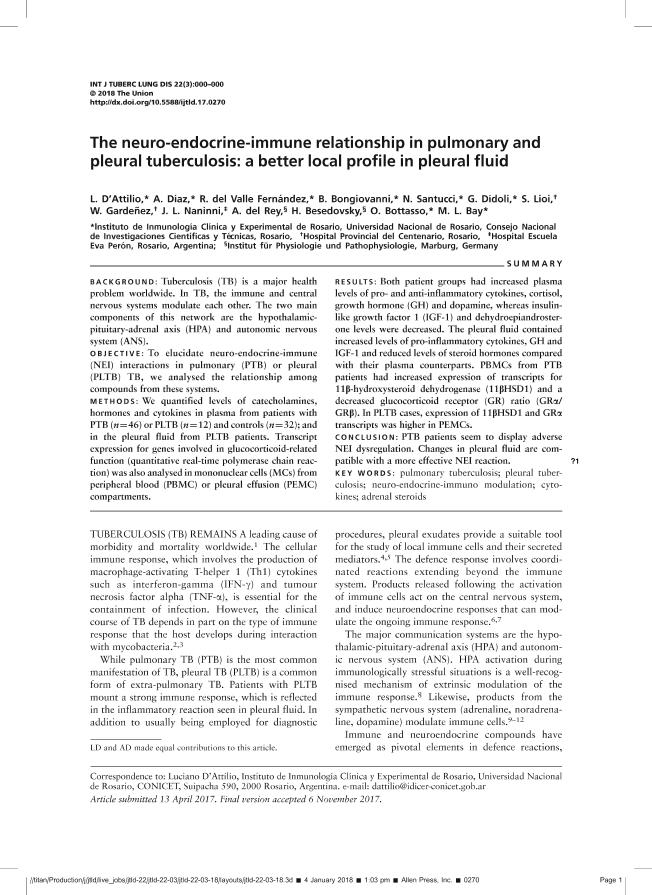Artículo
The neuro-endocrine-immune relationship in pulmonary and pleural tuberculosis: A better local profile in pleural fluid
D'attilio, Luciano David ; Díaz, Ariana
; Díaz, Ariana ; Fernández, Rocío del Valle
; Fernández, Rocío del Valle ; Bongiovanni, Bettina
; Bongiovanni, Bettina ; Santucci, Natalia Estefanía
; Santucci, Natalia Estefanía ; Dídoli, Griselda; Lioi, Susana; Gardeñez, W.; Naninni, J. L.; Del Rey, A.; Besedovsky, H.; Bottasso, Oscar Adelmo
; Dídoli, Griselda; Lioi, Susana; Gardeñez, W.; Naninni, J. L.; Del Rey, A.; Besedovsky, H.; Bottasso, Oscar Adelmo ; Bay, Maria Luisa
; Bay, Maria Luisa
 ; Díaz, Ariana
; Díaz, Ariana ; Fernández, Rocío del Valle
; Fernández, Rocío del Valle ; Bongiovanni, Bettina
; Bongiovanni, Bettina ; Santucci, Natalia Estefanía
; Santucci, Natalia Estefanía ; Dídoli, Griselda; Lioi, Susana; Gardeñez, W.; Naninni, J. L.; Del Rey, A.; Besedovsky, H.; Bottasso, Oscar Adelmo
; Dídoli, Griselda; Lioi, Susana; Gardeñez, W.; Naninni, J. L.; Del Rey, A.; Besedovsky, H.; Bottasso, Oscar Adelmo ; Bay, Maria Luisa
; Bay, Maria Luisa
Fecha de publicación:
03/2018
Editorial:
International Union Against Tuberculosis and Lung Disease
Revista:
International Journal of Tuberculosis and Lung Disease
ISSN:
1027-3719
e-ISSN:
1027-3719
Idioma:
Inglés
Tipo de recurso:
Artículo publicado
Clasificación temática:
Resumen
BACKGROUND: Tuberculosis (TB) is a major health problem worldwide. In TB, the immune and central nervous systems modulate each other. The two main components of this network are the hypothalamic-pituitary-adrenal axis (HPA) and autonomic nervous system (ANS). OBJECTIVE: To elucidate neuro-endocrine-immune (NEI) interactions in pulmonary (PTB) or pleural (PLTB) TB, we analysed the relationship among compounds from these systems. METHODS: We quantified levels of catecholamines, hormones and cytokines in plasma from patients with PTB (n = 46) or PLTB (n = 12) and controls (n = 32), and in the pleural fluid from PLTB patients. Transcript expression for genes involved in glucocorticoid-related function (quantitative real-time polymerase chain reaction) was also analysed in mononuclear cells (MCs) from peripheral blood (PBMC) or pleural effusion (PEMC) compartments. RESULTS: Both patient groups had increased plasma levels of pro- and anti-inflammatory cytokines, cortisol, growth hormone (GH) and dopamine, whereas insulin-like growth factor 1 (IGF-1) and dehydroepiandrosterone levels were decreased. The pleural fluid contained increased levels of pro-inflammatory cytokines, GH and IGF-1 and reduced levels of steroid hormones compared with their plasma counterparts. PBMCs from PTB patients had increased expression of transcripts for 11β-hydroxysteroid dehydrogenase (11βHSD1) and a decreased glucocorticoid receptor (GR) ratio (GRα/GRβ). In PLTB cases, expression of 11βHSD1 and GRα transcripts was higher in PEMCs. CONCLUSION: PTB patients seem to display adverse NEI dysregulation. Changes in pleural fluid are compatible with a more effective NEI reaction.
Archivos asociados
Licencia
Identificadores
Colecciones
Articulos(IDICER)
Articulos de INSTITUTO DE INMUNOLOGIA CLINICA Y EXPERIMENTAL DE ROSARIO
Articulos de INSTITUTO DE INMUNOLOGIA CLINICA Y EXPERIMENTAL DE ROSARIO
Citación
D'attilio, Luciano David; Díaz, Ariana; Fernández, Rocío del Valle; Bongiovanni, Bettina; Santucci, Natalia Estefanía; et al.; The neuro-endocrine-immune relationship in pulmonary and pleural tuberculosis: A better local profile in pleural fluid; International Union Against Tuberculosis and Lung Disease; International Journal of Tuberculosis and Lung Disease; 22; 3; 3-2018; 321-327
Compartir
Altmétricas



